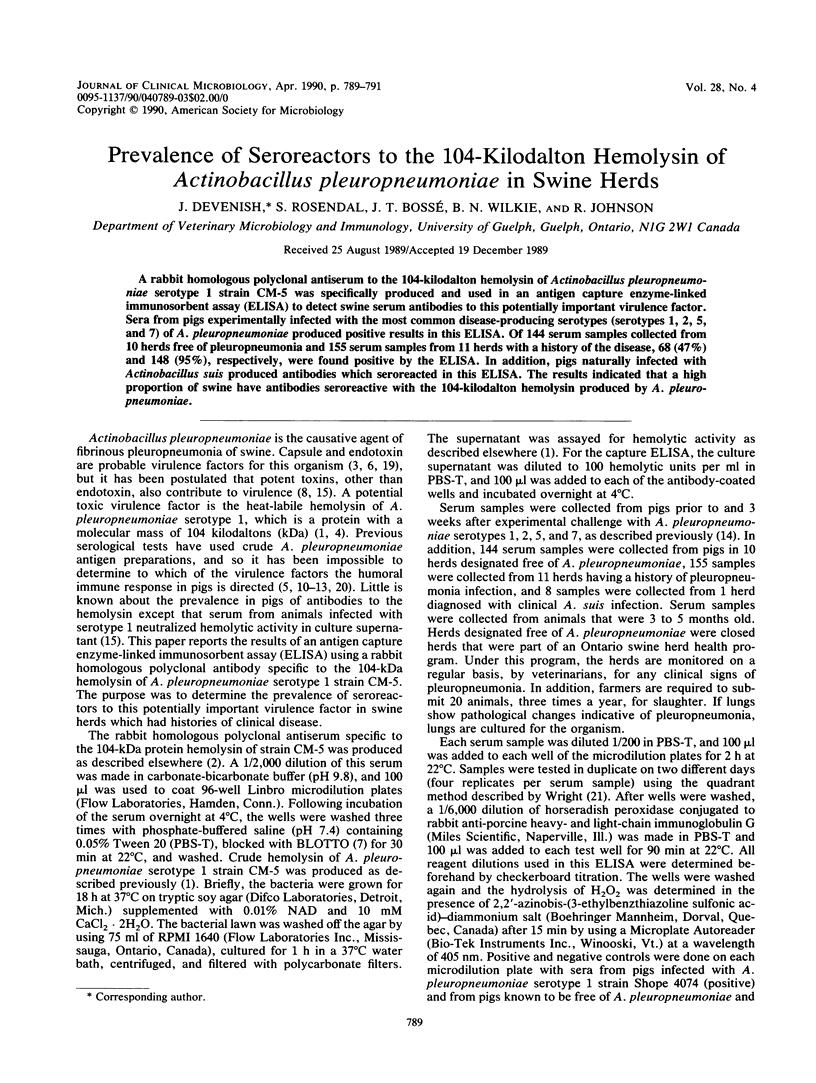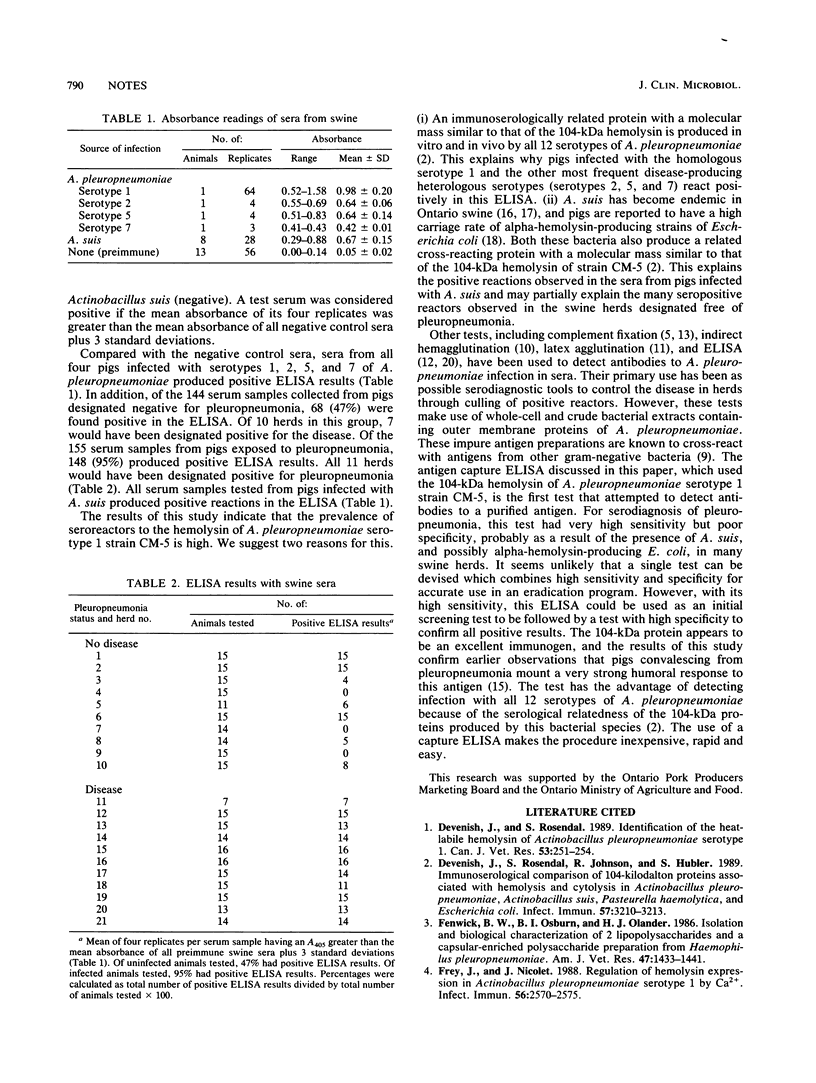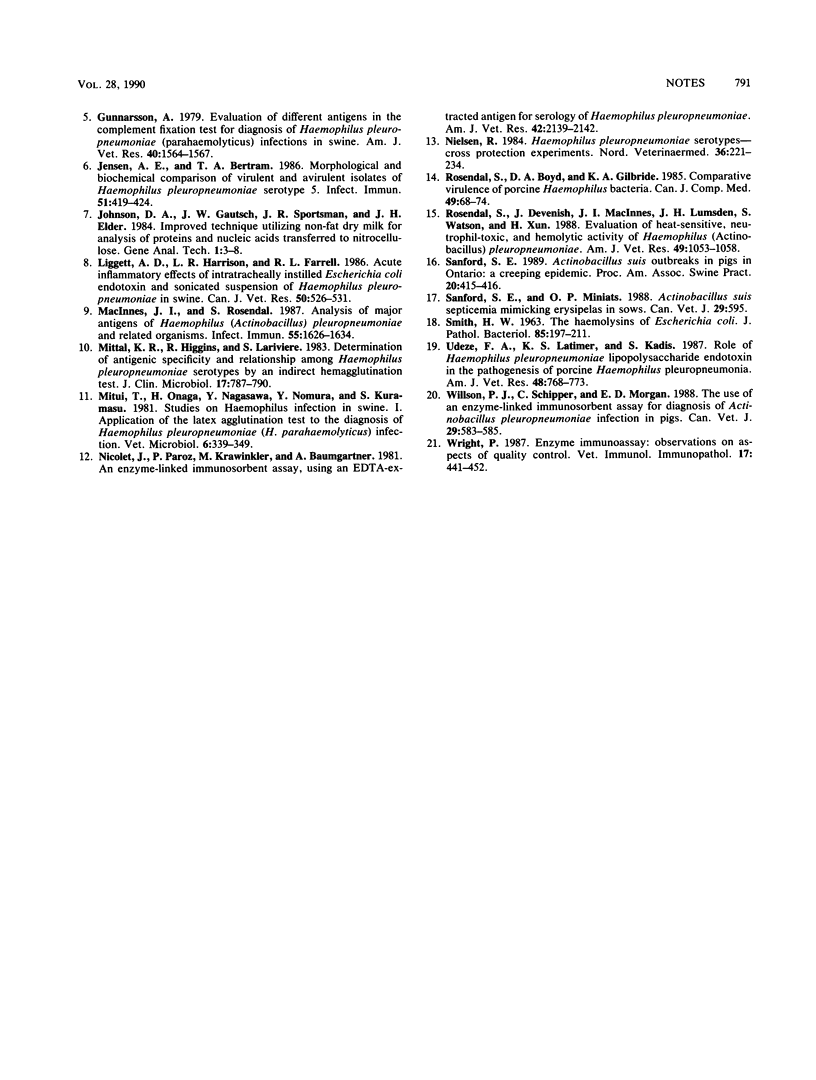Abstract
A rabbit homologous polyclonal antiserum to the 104-kilodalton hemolysin of Actinobacillus pleuropneumoniae serotype 1 strain CM-5 was specifically produced and used in an antigen capture enzyme-linked immunosorbent assay (ELISA) to detect swine serum antibodies to this potentially important virulence factor. Sera from pigs experimentally infected with the most common disease-producing serotypes (serotypes 1, 2, 5, and 7) of A. pleuropneumoniae produced positive results in this ELISA. Of 144 serum samples collected from 10 herds free of pleuropneumonia and 155 serum samples from 11 herds with a history of the disease, 68 (47%) and 148 (95%), respectively, were found positive by the ELISA. In addition, pigs naturally infected with Actinobacillus suis produced antibodies which seroreacted in this ELISA. The results indicated that a high proportion of swine have antibodies seroreactive with the 104-kilodalton hemolysin produced by A. pleuropneumoniae.
Full text
PDF


Selected References
These references are in PubMed. This may not be the complete list of references from this article.
- Devenish J., Rosendal S. Identification of the heat-labile hemolysin of Actinobacillus pleuropneumoniae serotype 1. Can J Vet Res. 1989 Apr;53(2):251–254. [PMC free article] [PubMed] [Google Scholar]
- Devenish J., Rosendal S., Johnson R., Hubler S. Immunoserological comparison of 104-kilodalton proteins associated with hemolysis and cytolysis in Actinobacillus pleuropneumoniae, Actinobacillus suis, Pasteurella haemolytica, and Escherichia coli. Infect Immun. 1989 Oct;57(10):3210–3213. doi: 10.1128/iai.57.10.3210-3213.1989. [DOI] [PMC free article] [PubMed] [Google Scholar]
- Fenwick B. W., Osburn B. I., Olander H. J. Isolation and biological characterization of two lipopolysaccharides and a capsular-enriched polysaccharide preparation from Haemophilus pleuropneumoniae. Am J Vet Res. 1986 Jul;47(7):1433–1441. [PubMed] [Google Scholar]
- Frey J., Nicolet J. Regulation of hemolysin expression in Actinobacillus pleuropneumoniae serotype 1 by Ca2+. Infect Immun. 1988 Oct;56(10):2570–2575. doi: 10.1128/iai.56.10.2570-2575.1988. [DOI] [PMC free article] [PubMed] [Google Scholar]
- Gunnarsson A. Evaluation of different antigens in the complement-fixation test for diagnosis of Haemophilus pleuropneumoniae (parahaemolyticus) infections in swine. Am J Vet Res. 1979 Nov;40(11):1564–1567. [PubMed] [Google Scholar]
- Jensen A. E., Bertram T. A. Morphological and biochemical comparison of virulent and avirulent isolates of Haemophilus pleuropneumoniae serotype 5. Infect Immun. 1986 Feb;51(2):419–424. doi: 10.1128/iai.51.2.419-424.1986. [DOI] [PMC free article] [PubMed] [Google Scholar]
- Liggett A. D., Harrison L. R., Farrell R. L. Acute inflammatory effects of intratracheally instilled Escherichia coli endotoxin and sonicated suspension of Haemophilus pleuropneumoniae in swine. Can J Vet Res. 1986 Oct;50(4):526–531. [PMC free article] [PubMed] [Google Scholar]
- MacInnes J. I., Rosendal S. Analysis of major antigens of Haemophilus (Actinobacillus) pleuropneumoniae and related organisms. Infect Immun. 1987 Jul;55(7):1626–1634. doi: 10.1128/iai.55.7.1626-1634.1987. [DOI] [PMC free article] [PubMed] [Google Scholar]
- Mittal K. R., Higgins R., Lariviere S. Determination of antigenic specificity and relationship among Haemophilus pleuropneumoniae serotypes by an indirect hemagglutination test. J Clin Microbiol. 1983 May;17(5):787–790. doi: 10.1128/jcm.17.5.787-790.1983. [DOI] [PMC free article] [PubMed] [Google Scholar]
- Nicolet J., Paroz P., Krawinkler M., Baumgartner A. An enzyme-linked immunosorbent assay, using an EDTA-extracted antigen for the serology of Haemophilus pleuropneumoniae. Am J Vet Res. 1981 Dec;42(12):2139–2142. [PubMed] [Google Scholar]
- Nielsen R. Haemophilus pleuropneumoniae serotypes--cross protection experiments. Nord Vet Med. 1984 Jul-Aug;36(7-8):221–234. [PubMed] [Google Scholar]
- Rosendal S., Boyd D. A., Gilbride K. A. Comparative virulence of porcine Haemophilus bacteria. Can J Comp Med. 1985 Jan;49(1):68–74. [PMC free article] [PubMed] [Google Scholar]
- Rosendal S., Devenish J., MacInnes J. I., Lumsden J. H., Watson S., Xun H. Evaluation of heat-sensitive, neutrophil-toxic, and hemolytic activity of Haemophilus (Actinobacillus) pleuropneumoniae. Am J Vet Res. 1988 Jul;49(7):1053–1058. [PubMed] [Google Scholar]
- SMITH H. W. The haemolysins of Escherichia coli. J Pathol Bacteriol. 1963 Jan;85:197–211. doi: 10.1002/path.1700850119. [DOI] [PubMed] [Google Scholar]
- Sanford S. E., Miniats O. P. Ontario. Actinobacillus suis septicemia mimicking erysipelas in sows. Can Vet J. 1988 Jul;29(7):595–595. [PMC free article] [PubMed] [Google Scholar]
- Udeze F. A., Latimer K. S., Kadis S. Role of haemophilus pleuropneumoniae lipopolysaccharide endotoxin in the pathogenesis of porcine Haemophilus pleuropneumonia. Am J Vet Res. 1987 May;48(5):768–773. [PubMed] [Google Scholar]
- Willson P. J., Schipper C., Morgan E. D. The Use of an Enzyme-linked Immunosorbent Assay for Diagnosis of Actinobacillus pleuropneumoniae Infection in Pigs. Can Vet J. 1988 Jul;29(7):583–585. [PMC free article] [PubMed] [Google Scholar]
- Wright P. Enzyme immunoassay: observations on aspects of quality control. Vet Immunol Immunopathol. 1987 Dec;17(1-4):441–452. doi: 10.1016/0165-2427(87)90160-7. [DOI] [PubMed] [Google Scholar]


